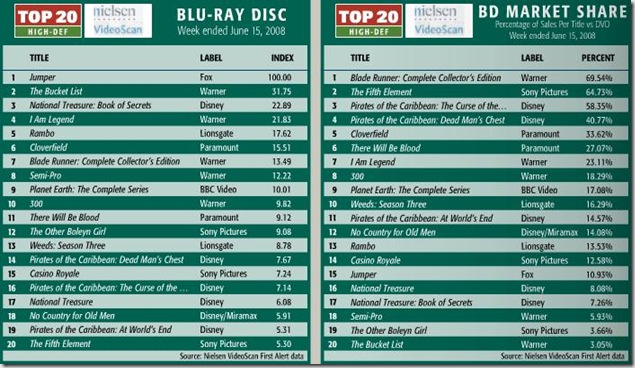 With the death of HD DVD, many of the format's most ardent supporters are proposing that Blu-ray will similarly becomes extinct in the near future due to an upcoming onslaught of digital download services. Some of these people are simply taking a page from the Microsoft playbook... whose main reason for supporting HD DVD appears to have been delaying Blu-ray's mass adoption until they had digital distribution ready to go. Others, however, seem to be buying into the same hype they fell for with HD DVD, and I would like to set the record straight -- so that these same consumers don't get burned a second time.
With the death of HD DVD, many of the format's most ardent supporters are proposing that Blu-ray will similarly becomes extinct in the near future due to an upcoming onslaught of digital download services. Some of these people are simply taking a page from the Microsoft playbook... whose main reason for supporting HD DVD appears to have been delaying Blu-ray's mass adoption until they had digital distribution ready to go. Others, however, seem to be buying into the same hype they fell for with HD DVD, and I would like to set the record straight -- so that these same consumers don't get burned a second time.
Don't get me wrong, there is true potential for digital download success, and there are some benefits to both the consumer and the movie studios... but it is neither a replacement for Blu-ray discs nor the second coming of Christ some seem to think it is.
Let's take a look at the various forms of digital distribution and their potential place in the market:
VOD:
VOD, or "Video on Demand" is a service provided by many cable companies where customers can essentially "rent" new release movies that are streamed from the cable company to the customers' television sets. This service is designed to go directly after the video rental market.
The benefits of VOD are that there is no additional equipment to buy and movie "rentals" begin immediately after choosing to rent them. The downsides (currently) are that the cable companies compress the signal to such a degree that HD signals frequently macro-block and rarely look much better than a DVD... while SD signals look no better than any other digital cable signal. These downsides are brought about largely by bandwidth limitations which will, over time, resolve themselves due to fiber-optical cabling being routed directly into customers' homes, as well as improvements in existing streaming techniques.
The question remains, however, whether the cable companies will choose to use the additional bandwidth to improve the quality of their releases, or to allow more titles to be offered. There is certainly financial incentive, though, to keep the individual titles at the lowest bitrate possible, and to use any additional storage and bandwidth available toward offering additional titles. The entire premise of VOD is that convenience trumps quality. Most films aren't even shown in their original aspect ratio... with the cable companies favoring "reformatted for your TV" transfers. While quality should improve somewhat over time... it is truly the convenience factor that the cable companies are selling.
Download Rental Services:
Rental services that download titles to a set-top box, video game system, or PC are just starting to emerge on the market in a major way. The major services offered at this point are the XBox Live Marketplace, AppleTV, and Netflix "Watch Instantly." These services, like VOD, have their sights targeted on the rental market.
The upside to these type of rental services is also convenience, and potentially, a larger portfolio of titles compared to VOD. Unlike store rentals, these titles are also never "checked out," adding to the convenience factor. The cost however, may be slightly higher than going to your local Blockbuster or Hollywood Video store, and the limitations are similar to VOD.
Quality is improving in the download rental service arena, with HD titles on Apple TV's service frequently besting the DVDs of the same title. They still aren't anywhere close to the quality of Blu-ray discs, but they can be good enough for many consumers.
Download-to-Own Services:
Similar to the download rental services, download-to-own services such as "Amazon Unboxed" strive to provide convenience to the customer -- though they do this at the cost of quality and flexibility that physical media provides.
This is the type of service that is designed to truly challenge physical media such as Blu-ray disc. Currently, most services are PC-based... severely limiting their appeal. But in the future, download rental services are likely to expand into the download-to-own arena.
Again, though, the focus is on convenience over quality. Even HD downloaded material is FAR below Blu-ray in quality, and while the quality will likely improve over time... it is still in the provider's financial interests to keep the total file size as small as possible. As the consumer will need to store the material on his or her hard drive, it will also be in the consumers' interest to keep file size down as much as possible.
The other problems with the download-to-own model (for consumers at least) is that your ownership of any title is predicated on the existence of the service and is tied to your owned hardware. You cannot "loan" a title to a friend... and if the service you subscribed to goes "bust" you run the risk of losing your purchased titles... especially if your player goes bad.
Conclusion:
The fact is we live in an immediate gratification society. People want things immediately. This certainly works to the advantage of digital distribution methods. Many consumers value convenience over quality: that can be seen in the success of audio downloading and in VHS's dominance over Laserdisc.
Fortunately, though, all is not lost for connoisseurs of quality media, and those who would like to be able to watch films they purchase whenever they like. Just as VOD didn't stop DVD from becoming the most successful media format in history, neither VOD or Digital Downloads seem likely to stop
Blu-ray from achieving widespread success. Even the download-to-own model has far too many limitations and lacks the convenience factor of Blu-ray. Add to that, bandwidth throttling and download caps being implemented by ISPs and the prospect of downloading feature-length HD video seems even less likely to make major inroads anytime soon.
Read More...
 With a slate of 70 titles scheduled for release in the month of July, all the major studios are pushing ahead with some great titles in the next month. While you can always see the full release schedule here, this post will highlight some of the bigger titles coming in the next month.
With a slate of 70 titles scheduled for release in the month of July, all the major studios are pushing ahead with some great titles in the next month. While you can always see the full release schedule here, this post will highlight some of the bigger titles coming in the next month.


![clip_image001[21]](http://lh6.ggpht.com/PopesVacation/SGJ2mdsCnzI/AAAAAAAACe0/wSwsiitLMD0/clip_image001%5B21%5D_thumb%5B3%5D.gif?imgmax=800)








